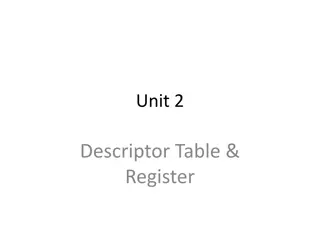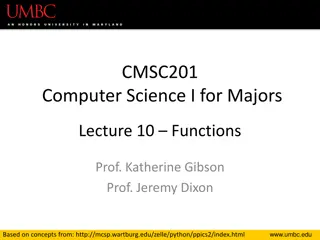Maintaining an Operating Table: Principles and Functions
An operating table system comprises three components - the table column, table top, and transporter, each available in different versions for various surgical disciplines. Stationary tables are anchored to the floor, offering flexibility to adapt to patient needs. Mobile tables provide maneuverability within the operating room. Basic functions of an operating table include adjustable height, tilt, and segments for anatomical positioning. Radiolucency and table rails are essential features for optimal functionality. Specialized tables like orthopaedic tables cater to specific surgical needs.
Download Presentation

Please find below an Image/Link to download the presentation.
The content on the website is provided AS IS for your information and personal use only. It may not be sold, licensed, or shared on other websites without obtaining consent from the author.If you encounter any issues during the download, it is possible that the publisher has removed the file from their server.
You are allowed to download the files provided on this website for personal or commercial use, subject to the condition that they are used lawfully. All files are the property of their respective owners.
The content on the website is provided AS IS for your information and personal use only. It may not be sold, licensed, or shared on other websites without obtaining consent from the author.
E N D
Presentation Transcript
Maintaining an operating table Maintaining an operating table o Principles of operation function use scientific principles o construction components system diagram inputs/outputs o troubleshooting identifying common faults replacing components rectifying faults o safety considerations user and patient safety electrical safety 13.6.2 Maintaining a operating table 13.6.2 Maintaining a operating table Unit B 13.6 Maintaining theatre and surgery equipment Unit B 13.6 Maintaining theatre and surgery equipment Module 279 18 B Medical Instrumentation I Module 279 18 B Medical Instrumentation I dr. Chris R. Mol, BME, NORTEC, 2015
Operating table: Principles of operation Operating table: Principles of operation An operating table system is made up of three components: operating table column table top transporter different versions of each component are available for specialists surgical disciplines Stationary tables Stationary tables The table column for a stationary operating table system is anchored to the floor. Additional necessary medical devices can easily be brought to the operating area and positioned. E.g. x-ray equipment can easily be slid under the table top. For personnel, the system offers good leg room. Additional elements can be connected to the operating table (rail). This flexibility is very important since it enables the table to be adapted to suit the relevant patient or the surgical discipline. Mobile tables Mobile tables The advantage of the mobile operating table is that the position of the table can be changed within the operating room. However, the foot of the table limits the leg space available to the surgical team. The individual segments of the table top can be easily removed and replaced. They also permit x-rays and conduct electricity. Maintaining an operating table dr. Chris R. Mol, BME, NORTEC, 2015
Operating table: Functions Operating table: Functions Basic functions that every operating table must fulfil. the height heightof an operating table must be adjustable. This is the only way a surgeon can adapt it to his/her height and thus work ergonomically. it must be possible to tilt tilt the table to the left and to the right to ensure a better overview into body cavities or to use gravity to move organs. the individual operating table segments table segments must also be adjustable adjustable. This is the only way to ensure the necessary anatomical bends of the body and enable extremities to be positioned suitable for operating. A further property of the operating table top is radiolucency should be as large as possible to ensure the largest possible image without disruption. Table rails Table rails are used to fix/attach supporting equipment The padding padding (cushions) of the table must be both soft and radiolucent. Soft because it must distribute the pressure of the patient body optimally, otherwise the patient may suffer pressure ulcers. radiolucency ( look through for X-rays). The radiolucent surface Maintaining an operating table dr. Chris R. Mol, BME, NORTEC, 2015
Operating table: Orthopaedic Operating table: Orthopaedic The Operating tables discussed here are general surgery tables. Specialized surgical departments may have specially designed tables for orthopaedic surgery, urology, etc. Orthopaedic tables provide an elevated surface for supporting the patient's body and include specific apparatus for supporting and/or providing traction for the patient's limbs during orthopaedic procedures. These tables stabilize the patient's position and provide optimal exposure of the surgical field General surgery tables can have (table rail attached) extensions which make these more suitable for special applications. Some orthopedic tables can accommodate C-arm radiographic/ fluoroscopic studies. Maintaining an operating table dr. Chris R. Mol, BME, NORTEC, 2015
Operating table: Construction Operating table: Construction Maintaining an operating table dr. Chris R. Mol, BME, NORTEC, 2015
Operating table: Components Operating table: Components Maintaining an operating table dr. Chris R. Mol, BME, NORTEC, 2015
Operating table: Construction Operating table: Construction Segment and Tilting movements are Hand operated Hand operated or Electric Motor driven Motor driven Up and Down movement is often hydraulic achieved by pumping a pedal, as with a car jack and dental chair hydraulic: Maintaining an operating table dr. Chris R. Mol, BME, NORTEC, 2015
Operating table: Preventive maintenance Operating table: Preventive maintenance As usual, there is maintenance to be done according to user and service manual after each operation: disinfection, drying (user) daily: cleaning, inspection, function checks (user), weekly: (oil) fluid levels, greasing (user) monthly: see below (BioMed tech) annual (BioMed tech) maintenance. And training to be given by BioMed techs to Users . e.g. Monthly maintenance e.g. Monthly maintenance Clean and lubricate pins and latches, spring loaded pins and pivoting ports with light machine oil or Vaseline Check castors that roll smoothly and floor lock is functioning correctly Test table functions by adjusting them to extreme position and back Check hand control unit and foot switch cables, connector and receptacle Maintaining an operating table dr. Chris R. Mol, BME, NORTEC, 2015
Operating table: Common Faults Operating table: Common Faults Table movement failure Table movement failure Check the main panel buttons for damage, the circuit board and wiring connections Unplug the hand controller plug, use a multi-meter to measure if connection is turned on. Contact the manufacturer to purchase PCB s and do the replacement. Sometimes the up-down control fails due to a jack problem there is no problem with the oil level, then the oil seal jack problem. In this case, oil should be added. If oil seal or piston piston may have the problem. Maintaining an operating table dr. Chris R. Mol, BME, NORTEC, 2015
Operating table: Trouble shooting Operating table: Trouble shooting Maintaining an operating table dr. Chris R. Mol, BME, NORTEC, 2015
Operating table: Safety considerations Operating table: Safety considerations Observe maximum allowed weight maximum allowed weight of the operating table Position Position the patient properly, as this affects the stability of the table Patients center of gravity should be over the base of the table Take extreme care when moving the table with patient on and make sure it is at minimum height. Avoid contact with any metal surfaces surgery (table side bars): both for patients and for users metal surfaces as they can cause burns during electro Maintaining an operating table dr. Chris R. Mol, BME, NORTEC, 2015
END END The creation of this presentation was supported by a grant from THET: see https://www.thet.org/























